Fine Hotels Resorts A Luxury Deep Dive
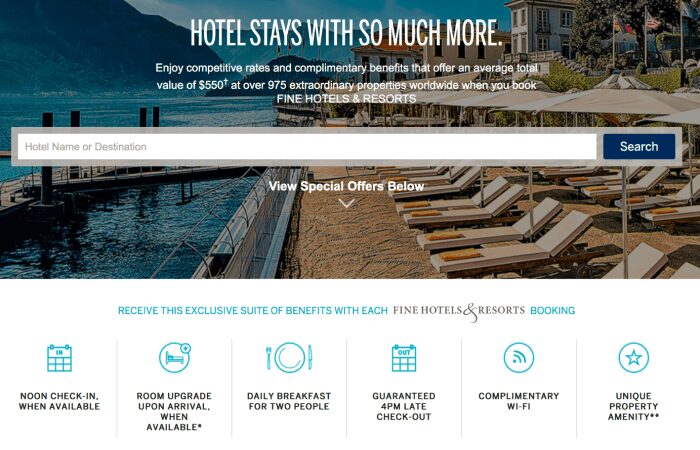
Fine Hotels Resorts represents the pinnacle of luxury travel, offering experiences far beyond the ordinary. They cater to discerning travelers seeking unparalleled service, exceptional amenities, and unforgettable locations. This exploration delves into what defines these exceptional establishments, examining their target audience, locations, services, pricing, competitive landscape, and marketing strategies.
From the meticulous design of their accommodations to the personalized attention of their staff, fine hotels and resorts create a world of pampering and sophistication. Understanding the nuances of this market segment requires examining everything from the subtle differences between a “fine hotel” and a “resort” to the sophisticated marketing techniques used to attract their affluent clientele. We’ll unpack the factors contributing to their success and explore the future trends shaping this dynamic industry.
Defining “Fine Hotels & Resorts”
So, what exactly sets a “fine hotel” and a “resort” apart from your average accommodation? It’s more than just a plush bed and a fancy lobby. Let’s dive into the defining characteristics of these luxurious experiences.
Fine hotels and resorts share some similarities, but their core experiences differ significantly. Both prioritize exceptional service and high-quality amenities, but resorts generally offer a more comprehensive and immersive experience, often focused on leisure and recreation.
Characteristics of Fine Hotels
Fine hotels prioritize impeccable service, luxurious accommodations, and a sophisticated atmosphere. They often feature exquisite dining options, well-appointed rooms and suites, and a curated selection of amenities tailored to a discerning clientele. Think personalized concierge services, state-of-the-art fitness centers, and exclusive access to events or experiences. The emphasis is on refined elegance and impeccable attention to detail. Location plays a significant role; fine hotels are often situated in prime city centers or iconic locations, providing easy access to cultural attractions and business hubs.
Characteristics of Resort Experiences
Resorts, on the other hand, typically focus on providing a complete vacation experience. They offer a wide array of recreational activities and amenities designed to keep guests entertained and relaxed. This could include multiple pools, spas, golf courses, water sports facilities, kids’ clubs, and various dining and entertainment options all within the resort property. The overall atmosphere is often more casual and laid-back compared to the formality of a fine hotel, although luxury resorts certainly exist and maintain high standards of service. The emphasis is on relaxation, recreation, and a self-contained getaway.
Comparing Amenities and Services
While both fine hotels and resorts offer high-quality amenities and services, their focus differs. Fine hotels concentrate on providing personalized service, sophisticated ambiance, and convenient access to urban attractions. Resorts prioritize a diverse range of leisure activities, extensive facilities, and a self-contained vacation environment. A fine hotel might offer a Michelin-starred restaurant and a rooftop bar with city views, while a resort might boast multiple swimming pools, a private beach, and a full-service spa. Both aim for exceptional service, but the nature of that service is tailored to the distinct experience each offers.
Fine Hotels vs. Resorts: A Feature Comparison, Fine Hotels resorts
| Hotel Feature | Fine Hotel Example | Resort Example | Key Difference |
|---|---|---|---|
| Location | Central London, near major attractions | Tropical beach setting, secluded location | Urban vs. natural environment |
| Dining | Multiple award-winning restaurants | Variety of casual and fine dining options, often themed | Focus on culinary excellence vs. diverse culinary experiences |
| Activities | Concierge-arranged tours, cultural events | On-site golf, water sports, spa treatments | Externally-focused activities vs. self-contained recreation |
| Ambiance | Sophisticated, elegant, formal | Relaxed, casual, family-friendly (often, but not always) | Level of formality and atmosphere |
Target Audience of Fine Hotels & Resorts: Fine Hotels Resorts
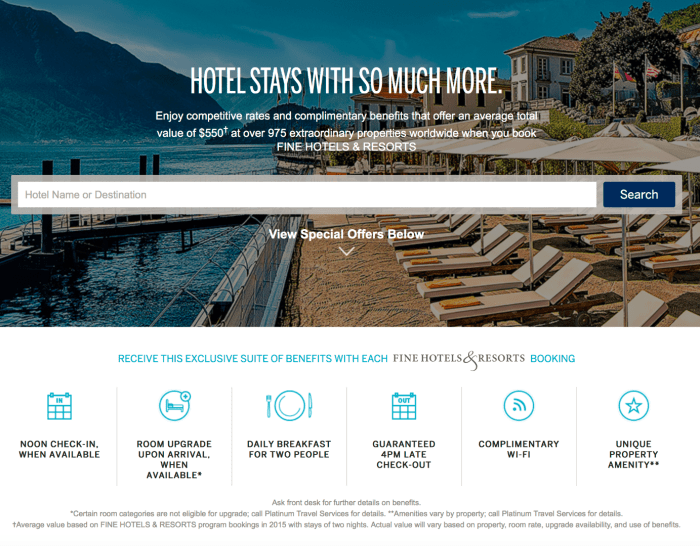
Source: zhimg.com
Fine hotels and resorts cater to a discerning clientele with specific needs and preferences. Understanding this target audience is crucial for effective marketing and operational strategies. This involves analyzing their demographics, psychographics, travel motivations, and spending habits to tailor experiences that resonate and drive loyalty.
The typical guest at a fine hotel or resort isn’t just looking for a place to sleep; they’re seeking a curated experience, a seamless blend of luxury, service, and unique offerings. This audience values exclusivity, personalized attention, and memorable moments. They are often willing to pay a premium for high-quality accommodations, exceptional service, and access to exclusive amenities and experiences.
Demographics and Psychographics of Fine Hotel Guests
This clientele typically comprises high-net-worth individuals, professionals, and affluent families. Demographics alone, however, don’t tell the whole story. Psychographically, these guests are often sophisticated, well-traveled, and appreciate bespoke experiences. They value privacy, personalized service, and authentic cultural immersion. They are often early adopters of luxury trends and seek unique and memorable travel experiences.
Motivations and Travel Styles of the Target Audience
Guests choosing fine hotels and resorts are driven by a variety of motivations, often intertwined. These include celebrating special occasions (anniversaries, honeymoons, birthdays), seeking relaxation and rejuvenation, experiencing unique cultural immersion, or engaging in specific activities like golf, spa treatments, or culinary explorations. Their travel style is often characterized by a preference for personalized itineraries, curated experiences, and a seamless, stress-free journey. They expect a high level of service and attention to detail throughout their stay.
Marketing Strategies Tailored to the Target Audience
Marketing to this audience requires a sophisticated approach that avoids generic advertising. Effective strategies focus on highlighting the unique aspects of the property and the bespoke experiences offered. This includes showcasing personalized service, exclusive amenities, and curated experiences through high-quality photography and videography. Targeted advertising on luxury travel platforms and partnerships with luxury brands are also highly effective. Email marketing campaigns featuring personalized offers and exclusive invitations to events are also a key component of successful outreach.
Segmentation of the Target Audience
Understanding the diverse needs of the target audience requires segmentation. Here are some key segments:
The following segments illustrate the diversity within the target audience, highlighting the need for tailored marketing and service strategies:
- Luxury Leisure Travelers: These individuals prioritize relaxation, rejuvenation, and personalized experiences. They often travel in couples or small groups and are willing to spend generously on spa treatments, fine dining, and other luxury amenities. Marketing should emphasize the resort’s spa facilities, gourmet dining options, and opportunities for relaxation and pampering.
- Adventure & Exploration Travelers: This segment seeks unique and immersive experiences, often involving adventure activities or cultural immersion. They value authentic experiences and are willing to venture off the beaten path. Marketing should focus on showcasing unique excursions, local cultural experiences, and opportunities for adventure.
- Corporate & Business Travelers: This segment prioritizes convenience, efficiency, and high-quality business amenities. They often travel solo or in small groups and value seamless service and access to business facilities. Marketing should emphasize the hotel’s business center, meeting rooms, and convenient location.
- Multigenerational Family Travelers: This segment seeks accommodations that cater to the needs of all family members, including children and grandparents. They value spacious accommodations, family-friendly amenities, and opportunities for shared experiences. Marketing should highlight family-friendly activities, spacious suites, and childcare services.
Location and Setting of Fine Hotels & Resorts
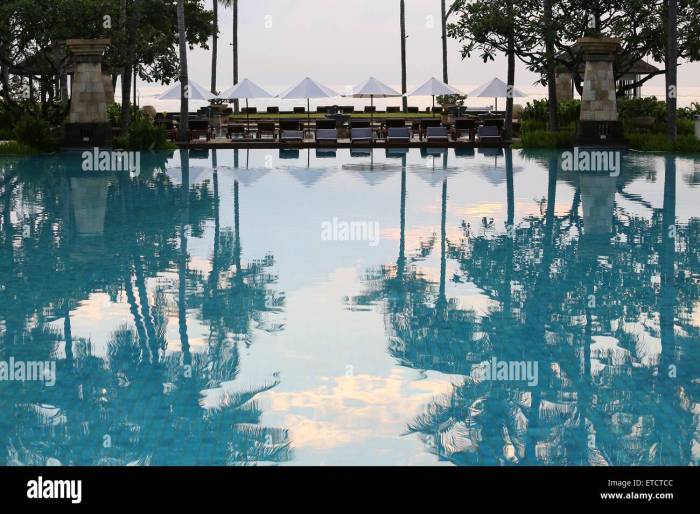
Source: alamy.com
Fine hotels and resorts understand that location is paramount to the overall guest experience. The setting significantly impacts the atmosphere, activities available, and the overall feeling of luxury and escape. A carefully chosen location is as crucial as the hotel’s architecture or service.
The impact of location on the guest experience is multifaceted. It dictates the views, accessibility to attractions, and overall ambiance. A beachfront resort offers a different experience than a city-center hotel, appealing to different preferences and desires. The surrounding environment, whether it’s bustling city life or serene natural beauty, directly contributes to the unique character of the hotel and its appeal to a specific clientele.
Types of Locations for Fine Hotels & Resorts
Fine hotels and resorts are strategically located to maximize their appeal to a target audience. Common locations include iconic city centers, breathtaking coastal areas, serene mountain retreats, and exclusive private islands. Each location provides a unique selling proposition and caters to a specific type of luxury traveler. For instance, a hotel situated in the heart of a vibrant metropolis offers easy access to cultural attractions, shopping, and fine dining, while a secluded island resort promises tranquility and privacy.
Urban Fine Hotels versus Rural/Resort Settings
Urban fine hotels provide access to the energy and excitement of city life. Guests enjoy proximity to world-class restaurants, museums, theaters, and shopping districts. The experience is often characterized by sophisticated elegance and convenience. Conversely, rural or resort settings prioritize tranquility and escape. These hotels often emphasize natural beauty, outdoor activities, and relaxation. Guests can expect breathtaking views, spa services, and opportunities for adventure such as hiking or watersports. The choice between an urban or rural setting depends entirely on the guest’s desired experience. A business traveler might prefer the convenience of an urban location, while a couple seeking a romantic getaway might choose a secluded resort.
Ideal Location for a Luxury Resort: A Visual Representation
Imagine a luxury resort nestled on a secluded cliff overlooking a pristine turquoise ocean. Lush, tropical vegetation cascades down the cliffside, creating a vibrant backdrop to the resort’s elegant architecture. The resort’s buildings are designed to blend seamlessly with the natural environment, using sustainable materials and incorporating local design elements. A private beach with soft, white sand is easily accessible, offering opportunities for swimming, sunbathing, and watersports. In the distance, a dramatic volcanic peak rises from the ocean, adding a sense of grandeur and natural wonder to the scene. The overall impression is one of unparalleled beauty, tranquility, and exclusive luxury. The resort offers breathtaking panoramic views, ensuring every guest enjoys a memorable and rejuvenating experience.
Services and Amenities Offered
Fine hotels and resorts go above and beyond the basics, providing a comprehensive suite of services and amenities designed to pamper and indulge their guests. These offerings are carefully curated to create an unforgettable and personalized experience, differentiating them from standard accommodations. The emphasis is always on exceeding expectations and providing a level of service that feels both seamless and anticipatory.
The range of services offered is extensive and varies depending on the specific property, but typically includes a wide array of options designed to cater to every need. Think of it as a curated collection of experiences rather than a simple list of services. The goal is to make the guest’s stay as effortless and enjoyable as possible, allowing them to relax and focus on enjoying their vacation or business trip.
Spa and Wellness Facilities
High-end hotels and resorts typically boast luxurious spas offering a comprehensive range of treatments, from massages and facials to hydrotherapy and body wraps. Many incorporate locally sourced products and techniques, adding a unique element to the experience. Beyond treatments, spas often include saunas, steam rooms, relaxation lounges, and fitness centers, creating a holistic wellness environment. For example, the Bulgari Resort Bali offers a spa featuring private villas with individual plunge pools, emphasizing seclusion and personalized pampering.
Concierge Services
Concierge services are a cornerstone of the fine hotel experience. Highly trained concierges act as personal assistants, anticipating guest needs and arranging everything from restaurant reservations and private transportation to securing tickets to sold-out events and planning bespoke excursions. Their expertise and local knowledge are invaluable in crafting a truly memorable stay. A top-tier concierge might even arrange a private helicopter tour or secure access to exclusive events not available to the general public.
Dining Experiences
Fine dining is a central feature of many luxury hotels and resorts. These establishments often boast multiple restaurants, each with its unique concept and culinary style. From Michelin-starred establishments to casual beachfront eateries, the dining options cater to diverse tastes and preferences. Beyond the food itself, the ambiance, service, and wine lists contribute to an exceptional dining experience. The emphasis is on using fresh, high-quality ingredients and providing impeccable service. For example, The Ritz-Carlton, Kapalua features several restaurants showcasing Hawaiian cuisine with stunning ocean views.
Exceptional Amenities
Unique amenities are what truly set fine hotels and resorts apart. These might include private butlers, dedicated beach cabanas with personalized service, private pools or plunge pools, chauffeured car services, exclusive access to nearby attractions, or curated experiences like private wine tastings or cooking classes. The possibilities are endless, and the goal is always to provide guests with experiences that they would not find anywhere else. For instance, some resorts offer personalized aromatherapy in rooms, reflecting individual guest preferences, or private yoga sessions on the beach at sunrise.
Technology’s Role in Enhancing Guest Experience
Technology plays a significant role in enhancing the luxury experience. This might include seamless mobile check-in and check-out, personalized in-room entertainment systems, voice-activated controls for lighting and temperature, high-speed Wi-Fi throughout the property, and smart room technology that allows guests to customize their environment. These technological advancements aim to create a more intuitive and efficient guest experience, anticipating needs and providing effortless control over the environment. For example, many high-end hotels use apps to allow guests to order room service, book spa treatments, and request amenities with a few simple taps.
Personalized Service: The Hallmark of Luxury
Personalized service is the key differentiator in the luxury hospitality sector. It’s about creating a tailored experience that caters to each guest’s individual preferences and needs. This is achieved through attention to detail, proactive service, and a genuine desire to exceed expectations.
- Remembering guest preferences and anticipating their needs (e.g., preferred room temperature, pillow type, beverage choices).
- Proactive communication and personalized recommendations (e.g., suggesting local restaurants based on guest interests, arranging private tours tailored to their preferences).
- Addressing guest requests promptly and efficiently, with a focus on exceeding expectations.
- Creating a warm and welcoming atmosphere that makes guests feel valued and appreciated.
- Offering bespoke services tailored to individual needs and interests (e.g., private yoga sessions, personalized spa treatments, curated excursions).
Pricing and Value Proposition
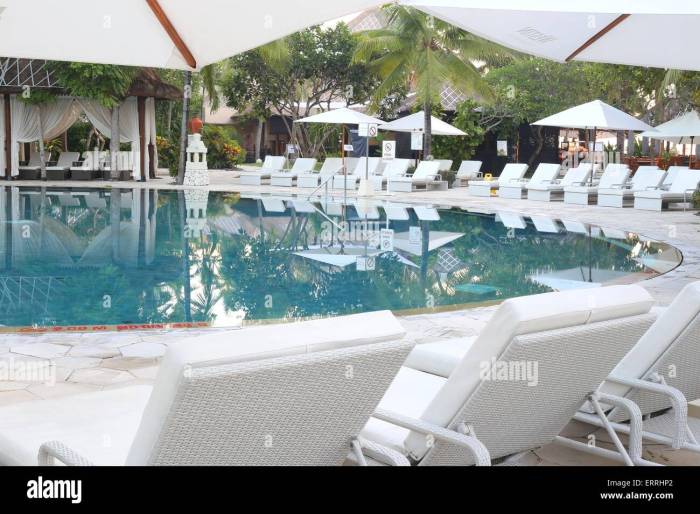
Source: alamy.com
Pricing a fine hotel or resort is a complex balancing act, requiring a deep understanding of the target market, the competitive landscape, and the unique value proposition offered. It’s not simply about the cost of construction and operation; it’s about crafting an experience that justifies the premium price tag. This involves careful consideration of various factors and a sophisticated pricing strategy.
Pricing Strategies for Fine Hotels and Resorts are multifaceted. They consider both the cost of providing services and the perceived value to the guest. High-end establishments often utilize dynamic pricing, adjusting rates based on demand, seasonality, and special events. This ensures optimal revenue generation while managing occupancy levels. Other strategies might involve package deals, loyalty programs, and tiered pricing for different room types or levels of service. A key aspect is understanding the price elasticity of demand – how sensitive guests are to price changes – and setting prices accordingly.
Factors Influencing Perceived Value
Several key factors contribute to the perceived value of a luxury stay. Beyond the tangible aspects like luxurious rooms and gourmet dining, the intangible elements play a significant role. Exceptional service, personalized attention, a sense of exclusivity, and memorable experiences contribute significantly to the overall value proposition. The ambiance, location, and reputation of the hotel also greatly influence the guest’s perception of value. A stay at a renowned hotel with a rich history and impeccable reputation will command a higher price than a comparable but lesser-known property. Ultimately, value is a subjective judgment based on the guest’s expectations and priorities.
Comparison of Pricing Models
Different fine hotels and resorts employ various pricing models, often a combination of approaches. Some may focus on a high-average daily rate (ADR) strategy, targeting a smaller segment of high-spending guests. Others may adopt a more mixed-strategy approach, offering a range of room types and packages to cater to a broader clientele. Boutique hotels might emphasize unique experiences and personalized service, justifying a higher price point through exclusivity and bespoke offerings. Large resorts might leverage economies of scale to offer competitive pricing on certain packages while maintaining higher rates for premium suites and services. For example, The Ritz-Carlton typically employs a high-ADR strategy focusing on personalized service and impeccable quality, while a large resort chain might offer various room categories and packages to attract a wider range of guests.
Hypothetical Pricing Structure for a New Luxury Resort
Let’s imagine a new luxury resort, “Serene Shores,” located on a secluded beach in the Caribbean. The resort features 100 rooms, ranging from standard rooms to lavish suites.
| Room Type | Low Season (USD) | High Season (USD) | Rationale |
|---|---|---|---|
| Standard Room | 800 | 1200 | Competitive pricing for a standard room in a luxury setting, reflecting the base level of amenities and services. |
| Deluxe Room (Ocean View) | 1200 | 1800 | Premium for ocean view and slightly larger size. |
| Luxury Suite (Private Balcony) | 2000 | 3000 | Significantly larger space, private balcony, and enhanced amenities justify the higher price. |
| Presidential Suite (Private Pool) | 5000 | 7500 | Exceptional space, private pool, butler service, and exclusive access to amenities justify the top price point. |
This structure considers seasonal fluctuations in demand, with higher prices during peak seasons. The rationale behind each price point reflects the relative value and amenities offered in each room type. The resort could further adjust prices based on real-time demand using dynamic pricing software. This approach allows for optimal revenue management and caters to different customer segments.
Competition and Market Trends
The fine hotels and resorts market is fiercely competitive, with established players and ambitious newcomers vying for a share of the luxury travel segment. Understanding the competitive landscape and prevailing trends is crucial for success in this dynamic industry. This section will examine major competitors, current industry trends, successful competitive strategies, and innovative adaptations to changing market demands.
Major Competitors in the Fine Hotels and Resorts Market
The luxury hospitality sector boasts a diverse range of competitors, each with its unique brand identity and target market. Leading players often include established international chains like Four Seasons Hotels and Resorts, Ritz-Carlton, The Peninsula Hotels, and Aman Resorts. These brands compete based on their consistently high standards of service, unique locations, and brand recognition. In addition, independent luxury hotels and boutique properties offer a distinct competitive advantage through personalized experiences and unique design aesthetics. The competitive landscape also includes smaller, regionally focused luxury brands that leverage local expertise and cultural immersion to attract discerning travelers.
Current Trends Shaping the Luxury Hospitality Industry
Several significant trends are reshaping the luxury hospitality landscape. Sustainability is increasingly important, with guests seeking eco-conscious accommodations and practices. This includes initiatives like reducing carbon footprints, sourcing local and sustainable food, and implementing responsible waste management programs. Wellness tourism is another booming trend, with guests prioritizing health and well-being during their travels. This manifests in hotels offering spa treatments, fitness facilities, healthy dining options, and wellness-focused activities. Technological advancements are also transforming the guest experience, with personalized services, contactless check-in/check-out, and smart room technology becoming increasingly prevalent. Finally, experiential travel is gaining traction, with guests seeking unique and immersive experiences beyond traditional sightseeing. This translates to hotels offering curated activities, local cultural immersion, and personalized itineraries.
Strategies Employed by Successful Competitors to Maintain Market Share
Successful luxury hotels employ several key strategies to maintain their market share. Brand building and loyalty programs are crucial for attracting and retaining guests. Consistent service excellence and staff training are paramount in ensuring guest satisfaction. Strategic partnerships with luxury brands and travel agencies expand reach and enhance the guest experience. Investment in technology and innovation helps to improve operational efficiency and enhance guest engagement. Finally, a strong focus on sustainability and social responsibility strengthens the brand image and appeals to environmentally and socially conscious travelers. For example, Four Seasons’ consistent commitment to sustainability initiatives and its global brand recognition has been instrumental in maintaining its position as a market leader.
Innovative Approaches to Adapt to Changing Market Demands
Fine hotels and resorts are adopting innovative approaches to meet evolving guest expectations. Personalization is key, with hotels leveraging data to tailor experiences to individual preferences. The integration of technology is enhancing guest convenience and creating seamless experiences. The rise of wellness tourism has prompted hotels to invest in state-of-the-art wellness facilities and programs. A focus on local experiences and cultural immersion creates authentic and memorable travel moments. For example, some hotels are partnering with local artisans and businesses to offer unique cultural experiences, allowing guests to immerse themselves in the local culture. Others are investing in innovative technology, such as AI-powered chatbots, to enhance guest service and provide personalized recommendations. The adoption of flexible cancellation policies and the introduction of hybrid work/leisure packages are also examples of adaptation to the evolving needs of modern travelers.
Branding and Marketing
In the fiercely competitive world of luxury hospitality, a strong brand is more than just a logo; it’s the embodiment of a promise, an experience, and a lifestyle. Effective branding differentiates fine hotels and resorts, commands premium pricing, and fosters unwavering guest loyalty. Marketing, in turn, acts as the bridge, connecting the brand’s essence with its discerning target audience.
Branding Strategies of Successful Fine Hotels and Resorts
Successful luxury hotels understand the power of consistent brand messaging across all touchpoints. They craft narratives that resonate with their ideal guest, conveying a sense of exclusivity, sophistication, and unparalleled service. For instance, The Ritz-Carlton consistently delivers on its promise of impeccable service and personalized experiences, building a brand synonymous with refined luxury. Similarly, Four Seasons Hotels and Resorts cultivates a reputation for understated elegance and exceptional attention to detail, creating a feeling of seamless comfort and personalized care. These brands don’t just sell rooms; they sell an aspirational lifestyle. Their marketing materials consistently showcase this lifestyle, from breathtaking photography to carefully curated storytelling.
Marketing Campaigns Tailored to the Target Audience
Marketing campaigns for fine hotels and resorts are highly targeted and personalized. They leverage data-driven insights to understand guest preferences and behaviors, allowing for customized messaging and offers. This might involve utilizing sophisticated CRM systems to track guest interactions and preferences, enabling personalized email campaigns and targeted advertising. Social media platforms are also strategically used to engage with potential guests, showcasing the hotel’s unique features and experiences through high-quality visuals and engaging content. Influencer marketing plays a significant role, with collaborations with travel bloggers and luxury lifestyle influencers amplifying the brand’s reach and credibility within the target demographic. Consider, for instance, a campaign featuring stunning drone footage of a secluded beachfront resort, shared across Instagram and YouTube, reaching a highly engaged audience interested in luxury travel and relaxation.
A Marketing Campaign for “Serene Shores Resort”
Serene Shores Resort Marketing Campaign
This campaign focuses on a fictional luxury resort, “Serene Shores Resort,” located on a private island in the Maldives. The target audience is high-net-worth individuals and couples seeking an exclusive, romantic getaway.
The campaign’s central theme is “Unwind.Reconnect.Rejuvenate.” This concisely captures the resort’s essence: a tranquil escape that fosters intimacy and personal well-being.
Key Elements:
- High-quality photography and videography showcasing the resort’s stunning location, luxurious villas, and exceptional amenities. This includes aerial shots of the island, close-ups of lavish interiors, and footage of couples enjoying spa treatments and private dining experiences.
- Targeted digital advertising on platforms like Instagram, Facebook, and YouTube, focusing on luxury travel and lifestyle audiences. This will involve utilizing visually appealing ads featuring stunning imagery and compelling copy.
- Partnerships with luxury travel agencies and concierge services to promote the resort to its high-net-worth clientele. This will leverage established relationships and trust within the target market.
- Email marketing campaigns targeting past guests and those who have expressed interest in luxury travel destinations. These campaigns will be personalized based on individual preferences and past interactions.
- Public relations efforts to secure features in prestigious travel magazines and websites, further enhance the resort’s credibility and visibility.
Target Channels:
- Luxury travel publications (e.g., Condé Nast Traveler, Travel + Leisure)
- High-end travel agencies and concierge services
- Social media platforms (Instagram, Facebook, YouTube)
- Email marketing
- Influencer marketing collaborations
Concluding Remarks
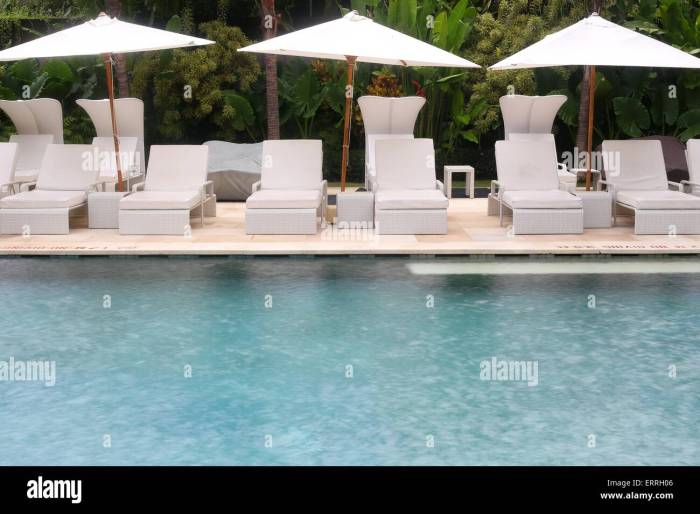
Source: alamy.com
Ultimately, the success of fine hotels and resorts hinges on a perfect blend of impeccable service, luxurious amenities, strategic location, and effective branding. By understanding the unique needs and desires of their target audience and adapting to evolving market trends, these establishments continue to offer unparalleled travel experiences. The future of luxury hospitality promises even more innovative approaches to personalized service and sustainable luxury, ensuring that the allure of a fine hotel or resort remains a coveted aspiration for discerning travelers worldwide.
Query Resolution
What’s the difference between a boutique hotel and a fine hotel resort?
Boutique hotels are smaller, often independently owned, and emphasize unique character and personalized service. Fine hotels and resorts encompass a broader range, including large luxury chains, and focus on high-end amenities and services across a larger scale. Resorts typically offer more extensive recreational facilities.
How can I find the best deals on fine hotels and resorts?
Consider booking during the off-season or shoulder season for lower rates. Utilize travel agent services or loyalty programs, explore travel websites offering package deals, and be flexible with your travel dates.
Are there eco-friendly fine hotels and resorts?
Yes, many luxury hotels and resorts are increasingly incorporating sustainable practices. Look for certifications like LEED or Green Globe, and check their websites for information on their sustainability initiatives.
What should I pack for a stay at a fine hotel resort?
Pack versatile, elegant clothing suitable for various occasions. Don’t forget comfortable walking shoes, swimwear (if applicable), and any necessary medications. Check the resort’s amenities to see what they provide before packing toiletries.
Comments are closed.